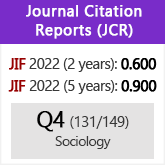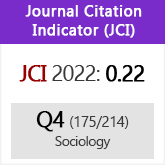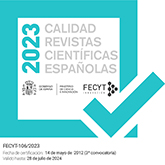Giving birth to death.Life professionals managing the bereavement
DOI:
https://doi.org/10.3989/ris.2017.75.3.15.189Keywords:
Coping Models, Health Care Professional, Neonatal death, Perinatal BereavementAbstract
The aim of the study was to investigate the main representations, experiences and coping strategies developed by health professionals involved in perinatal bereavement care. A qualitative and phenomenological approach was used conducting a series of semi-structured interviews to professionals of different categories of obstetric areas of three public hospitals in the region of Murcia. The stories talk about of professionals trained for the life they have to face death, talk about of a lack of institutional training to the professionals react drawing on the experience, empathy or self-taught. They talk about painful situations that are experienced by clinicians with hints of tragedy, speak of care directed to the psychological management of mourning, talks about the transition from coping models duels based on avoidance and emotional detachment to others centered on the verbalization of experience and contact with the stillborn.
Downloads
References
Allchin, L. 2006. "Caring for the dying: Nursing student perspectives". Journal of Hospice & Palliative Nursing 8: 112-119. https://doi.org/10.1097/00129191-200603000-00015
Bauman, Z. 2001. La posmodernidad y sus descontentos. Madrid: Akal.
Beck, U. 1998. La sociedad del riesgo. Hacia una nueva modernidad. Paidós: Barcelona.
Bertaux D. 1993. "Los relatos de vida en el análisis social". Pp. 136-148 en Historia oral, compilado por J. Aceves. Ciudad de México D.F.: Universidad Autónoma Metropolitana.
Bonanno, G. A. 2009. The other side of sadness: What the new science of bereavement tells us about life after loss. New York: Basic Books
Bowlby, J. 1980. Attachment and loss: Loss, sadness, and depression. Nueva York: Basic Books. PMCid:PMC1715712
Bourne, S. 1968. "The psychological effects of stillbirths on women and their doctors". British Journal of General Practice 16: 103-112.
Badenhorst, W. and P. Hughes. 2007. "Psychological aspects of perinatal loss". Best Practice & Research Clinical Obstetrics & Gynaecology 21: 249-259. https://doi.org/10.1016/j.bpobgyn.2006.11.004 PMid:17196434
Cacciatore, J. 2010. "Stillbirth: Patient-centered psychosocial care". Clinical Obstetrics Gynecology 53: 691-699. https://doi.org/10.1097/GRF.0b013e3181eba1c6 PMid:20661053
Cacciatore, J. 2013. "Psychological effects of stillbirth". Seminars in Fetal & Neonatal Medicine 18: 76-82. https://doi.org/10.1016/j.siny.2012.09.001 PMid:23040157
Camus, A. 1965. Le mythe de Sisyphe. Essais. París: Gallimard.
Charmaz, K. 2006. Constructing Grounded Theory: A Practical Guide through Qualitative Analysis. London: Sage Publications.
Chan, M. F., F. L. Lou, D. G. Arthur, F. L. Cao, L. H. Wu, P. Li, M. Sagara-Rosemeyer and L. Lui. 2008. "Investigating factors associate to nurses' attitudes towards perinatal bereavement care". Journal of Clinical Nursing 17: 509-518. https://doi.org/10.1111/j.1365-2702.2007.02007.x PMid:18205683
Coffey, A. y P. Atkinson. 2005. Encontrar el sentido a los datos cualitativos. Medellín: Universidad de Antioquia de Medellín.
Côte-Arsenault, D. and E. Denney-Koelsch. 2011. "My baby is a person: Parents experiences with life-threatening fetal diagnosis". Journal of Palliative Medicine 14: 1302- 1308. https://doi.org/10.1089/jpm.2011.0165 PMid:22077542
Delgado, J. C. & M. Monzón. 2002. "Estudio sobre la vivencia de la muerte entre los sanitarios". Cultura de los cuidados: Revista de enfermería y humanidades 12: 81-90.
Derrida, J. 1996. Aporías; Morir-esperares (en) los límites de la verdad. Barcelona: Paidós.
Domínguez, B. y S. Urraca. 1985. "Opiniones de los médicos y enfermeras sobre el dolor y la muerte de pacientes terminales". Jano 654: 67-68.
Doka, K. J. 2002. Disenfranchised grief: New directions, challenges, and strategies for practice. Michigan: Research Press Publishers.
Elia, A. D. 1959. "The management of grief situations in obstetrics". BMQ; The Boston medical quarterly 10: 6-12. PMid:13638226
Fernández, M., F. Cruz, N. Pérez y H. Robles. 2012. "Factores psicológicos implicados en el duelo perinatal". Index de Enfermería 21: 48-52. https://doi.org/10.4321/S1132-12962012000100011
Fenwick, J., B. Jennings, J. Downie, J. But y M. Okanaga. 2007. "Providing perinatal loss care: satisfying and dissatisfying aspects form midwives". Women and Birth 20: 153-160. https://doi.org/10.1016/j.wombi.2007.09.002 PMid:17964235
Gabilondo, A. 2003. Mortal de necesidad: la filosofía, la salud y la muerte. Madrid: Abada Editores.
Gálvez, A. 2006. "Muerte alrededor del nacimiento: creencias, sentimientos y vivencias, una perspectiva de los profesionales de los cuidados". Tesis Doctoral. Departamento de Enfermería, Universidad de Alicante, Alicante.
García-Caro, M. P, F. Cruz, J. Schmidt, A. Mu-oz, R. Montoya, D. Prados y M. C. Botella. 2010. "Influencia de las emociones en el juicio clínico de los profesionales de la salud a propósito del diagnóstico de enfermedad terminal". International Journal of Clinical and Health Psychology 10:57-73.
Gardner, J. M. 1999. "Perinatal death: uncovering the needs of midwives and nurses and exploring helpful interventions in the United States, England and Japan". Journal of Transcultural Nursing 10: 120-130. https://doi.org/10.1177/104365969901000205 PMid:10476163
Giddens, A. 1993. Consecuencias de la modernidad. Alianza: Madrid.
Glaser, B. G. and A. L. Strauss. 1967. The discovery of grounded theory: Strategies for qualitative research. New York: Aldine de Gruyter. PMCid:PMC224645
Goffman, E. 1987. La presentación de la persona en la vida cotidiana. Buenos Aires: Amorrortu. PMid:3305442
Gold, K. J., V. K. Dalton and T. L. Schwenk. 2007. "Hospital care for parents after perinatal death". Obstetrics and Gynecology 109: 1156-1166. https://doi.org/10.1097/01.AOG.0000259317.55726.df PMid:17470598
Gómez, M. 2003. "Morir con dignidad II: La esfera espiritual del hombre al final de la vida. Muerte y religión". Pp. 262-271 en Avances en Cuidados Paliativos. Las Palmas: Gafos.
Hammersley, M. and P. Atkinson. 1994. Etnografía. Métodos de investigación. Barcelona: Paidós Ibérica. PMCid:PMC1415063
Heazell, A. E. P., M. J. McLaughlin, E. B. Schmidt, P. Cox, V. Flenady, T. Y. Khong and S. Downe. 2012. "A difficult conversation? The views and experiences of parents and professionals on the consent process for perinatal postmortem after stillbirth". BJOG: An international journal of obstetrics & Gynaecology 119: 987-997. https://doi.org/10.1111/j.1471-0528.2012.03357.x PMid:22587524
Heidegger, M. 1997. El ser y el tiempo. Santiago de Chile: Editorial Universitaria.
Hernández, R., C. Fernández y L. Baptista. 2014. Metodología de la investigación. México: Mc Graw Hill.
Instituto Nacional de Estadística. 2013. Secretaría de Estado de Economía y Apoyo a la Empresa. Mortalidad infantil. Tasa de mortalidad perinatal. Madrid: INE.
Jonas-Simpson, C., G. J. Michell, A. Fisher, G. Jones and J. Linscott. 2006. "The experience of being listened to: a qualitative study of older adults in long-term care settings". Journal of Gerontological Nursing 32: 46-53. https://doi.org/10.3928/0098-9134-20060101-15 PMid:16475465
Jonas-Simpson, C., E. McMahon, J. Watson y L. Andrews. 2010. "Nurses experiences of caring for families whosebabies were born still or died shortly after birth". International Journal for Human Caring 14: 14-21.
Jonas-Simpson, C., F. B. Pilkington, C. MacDonald y E. McMahon. 2013. "Nurses experiences of grieving when there is a perinatal death". SAGE Open 3(2): 1-11. https://doi.org/10.1177/2158244013486116
Jones, K and L. Smythe. 2015. "The impact on midwives of their first stillbirth". New Zealand College of Midwives Journal 51: 17-22. https://doi.org/10.12784/nzcomjnl51.2015.3.17-22
Kirkley-Best, E. & K. R. Kellner. 1982. "The forgotten grief: A review of the psychology of stillbirth". American Journal of Orthopsychiatry 52: 420-429. https://doi.org/10.1111/j.1939-0025.1982.tb01428.x PMid:7114170
Kübler-Ross, E. 1969. On death and dying. New York: The Macmillan Company.
Mander, R. 1994. Loss and bereavement in childbearing. Oxford: Blackwell Publishing.
Marín, E. 2007. La muerte en la vida del ser humano. Logro-o: Instituto de Estudios Riojanos.
Mejías, M. C, S. García y L. Duarte. 2012. Guía clínica de abordaje del duelo perinatal. Madrid: Bubok Publishing.
(de) Miguel, J. M. 1995. "El último deseo. Para una sociología de la muerte en Espa-a". Revista Espa-ola de Investigaciones Sociológicas (REIS) 71-72: 109-156.
Morin, E. 1994. El hombre y la muerte. Barcelona: Editorial Kairós.
Nuzum, D; S. Meaney and K. O’Donoghue. 2014. "The impact of stillbirth on consultant obstetrician gynaecologists: a qualitative study". BJOG: An International Journal of Obstetrics and Gynaecology 121: 1020-1028. https://doi.org/10.1111/1471-0528.12695 PMid:24589177
Pangrazzi, A. 1993. La pérdida de un ser querido: un viaje dentro de la vida. Granada: Ed. Paulinas. PMid:8483002
Parkes C. M. 1972. Berearement: Studies of grief in adult life. Nueva York: International Universities Press.
Pastor, S. M., J. M. Romero, C. H. Montoro, L. M. Crespo, V. A. G. Jaén and R. M. B. Tirado. 2011. Experiences with perinatal loss from the health professionals perspectives. Latin American Journal of Nursing 19: 1405-1412.
Pastor, S. M., J. M. Romero, J. C. Paramio, C. Hueso, O. Paloma, M. Lillo, A. C. Toledano; C. Carnicer; J. A. Ortegón y A. J. Frandsen. 2012. "Tackling perinatal loss, a participatory action research approach: research protocol". Journal of advanced nursing 68: 2578-2585. https://doi.org/10.1111/j.1365-2648.2012.06015.x PMid:22515822
Payás, A. 2010. Las tareas del duelo. Psicoterapia del duelo desde un modelo integrativo-relacional. Barcelona: Editorial Paidós. PMid:21073597
Pellegrino, E. 1985. "The Caring Ethic: The relation of physican to patient", Pp 8-3 en Caring, curing, coping nurse, physician, patient relationships, editado por A.H. Bishop and J.R: Scudder. Birmingham, AL: University of Alabama Press.
Puia, D. M., L. Lewis y C. T. Beck. 2013. "Experiences of obstetric nurses who are present for a perinatal loss". Journal of Obstetric, Gynecologic, & Neonatal Nursing 42: 321- 331. https://doi.org/10.1111/1552-6909.12040 PMid:23682697
Roehrs, C., A. Masterson, R. Alles, C. Witt & P. Rutt. 2008. "Caring for families coping with perinatal loss". Journal of Obstetric, Gynecologic, & Neonatal Nursing 37: 631-639. https://doi.org/10.1111/j.1552-6909.2008.00290.x PMid:19012713
Savage, J. A. 1992. Duelo por las vidas no vividas. Barcelona: Luciérnaga.
Strauss. A. and J. Corbin. 1990. Basics of qualitative research Grounded theory procedures and techniques. Newbury Park: Sage Publications.
Strauss, A. and J. Corbin. 1998. Basics of qualitative research techniques and procedures for developing grounded theory. Thousand Oaks: Sage Publications
Stroebe, M., & H. Schut. 1999. "The dual process model of coping with bereavement: Rationale and description". Death Studies 23: 197-224. https://doi.org/10.1080/074811899201046 PMid:10848151
Taylor, S. y R. Bogdan. 1998. Introducción a los métodos cualitativos de investigación la búsqueda de significados. Buenos Aires: Paidós.
Wallbank, S y N. Robertson. 2008. "Midwife and nurse responses to miscarriage, stillbirth and neonatal death: a critical review of qualitative research". Evidence Based Midwifery 6: 100-106.
Walter, T. 1994. The Revival of Death. London: Routledge. https://doi.org/10.4324/9780203220306
Worden, J. W., Á. Aparicio y G. S. Barberán. 1997. El tratamiento del duelo: asesoramiento psicológico y terapia. Barcelona: Paidós. PMCid:PMC1759579
Published
How to Cite
Issue
Section
License
Copyright (c) 2017 Consejo Superior de Investigaciones Científicas (CSIC)

This work is licensed under a Creative Commons Attribution 4.0 International License.
© CSIC. Manuscripts published in both the printed and online versions of this Journal are the property of Consejo Superior de Investigaciones Científicas, and quoting this source is a requirement for any partial or full reproduction.All contents of this electronic edition, except where otherwise noted, are distributed under a “Creative Commons Attribution 4.0 International” (CC BY 4.0) License. You may read here the basic information and the legal text of the license. The indication of the CC BY 4.0 License must be expressly stated in this way when necessary.
Self-archiving in repositories, personal webpages or similar, of any version other than the published by the Editor, is not allowed.

















